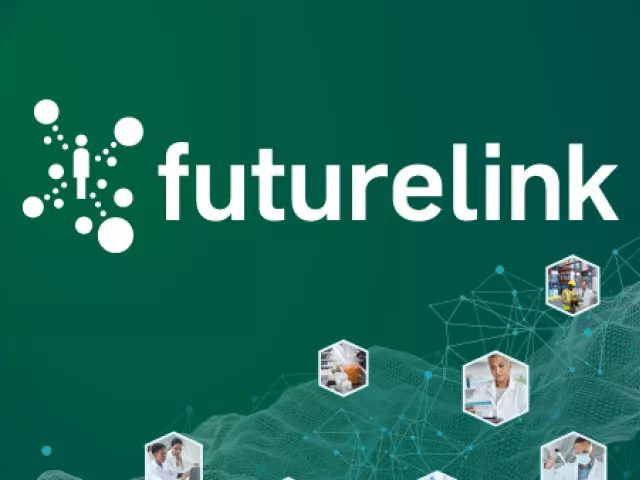Table of contents
TraceLink's OPUS digital network platform enables end-to-end supply chain digitalization for materials suppliers, pharmaceutical companies, contract manufacturers, wholesale distributors, health systems, and retail pharmacies across the global life sciences and healthcare supply chain.
But TraceLink didn't build that network alone, according to Shabbir Dahod, the president and CEO of TraceLink. It was a collaborative, industry-wide effort, initially spurred on by the need to meet new regulatory track-and-trace requirements in markets across the globe, but has since evolved to encompass so much more. That was the key takeaway from Dahod’s keynote presentation at FutureLink Boston 2024.
"What we have done together in partnership with all of you is we have actually constructed the largest end-to-end digitalization effort ever done in any industry," said Dahod, who was speaking before a crowded room of TraceLink customers and partners at FutureLink. "That is something that should make everyone here incredibly proud."
Today, the TraceLink network consists of more than 291,000 authenticated and onboarded companies across the end-to-end life sciences and healthcare supply chain. But what brings the network to life are the more than 339,000 active network links—network-based connections between individual companies—that enable the seamless and fully interoperable exchange of serialized product information, business transactions like advance ship notices (ASNs), and much more.
Dahod went on to say the powerful new network-based digital solutions and capabilities that enable TraceLink customers and their trading partners to digitalize and orchestrate their end-to-end supply chains.
Centrally manage your supply chain with OPUS Ensemble
As digitalization opens up new opportunities for supply chain orchestration, life sciences and healthcare professionals will be leveraging a multitude of different solutions and applications to manage their supply chain operations. This highlights the importance of user experience: powerful applications are critical to operational success, but equally critical is how accessible, intuitive, and usable these applications are in a live environment.
OPUS Ensemble provides a next-generation experience that enables users to seamlessly switch between TraceLink supply chain orchestration solutions from a single, centralized virtual location, with a layout that calls to attention important information and notifications. With OPUS Ensemble, users can monitor product recall status, coordinate with partners on compliance exceptions, and manage product serialization, all from one place. Watch this quick video to learn more about OPUS Ensemble.

“What you see here is the ability to work seamlessly across multiple different supply chain dimensions,” Dahod said of OPUS Ensemble.
Digitalize your end-to-end supply chain with TraceLink MINT
TraceLink Multienterprise Information Network Tower (MINT) uses the proven TraceLink network and its powerful Integrate-Once, Interoperate with Everyone™ capability to enable integration with 100% of your supply chain partners at a fraction of the cost and time of alternative methods like EDI or point-to-point integration models.
With MINT, a single connection to the TraceLink network per transaction type enables the real-time exchange of purchase orders, invoices, ASNs, production forecasts, and most other common business transactions with all of your supply chain partners with complete interoperability. Watch this quick video to learn more:

“Now you see the full vision here: the ability to achieve end-to-end digitalization on top of this track-and-trace infrastructure,” Dahod said. “We’ve all put in a tremendous amount of work to create this foundation of capability, and now we have the capability to take on more challenging problems.”
Reduce disruption with Supply Chain Work Management (now POET) for Compliance Exceptions
When the U.S. Drug Supply Chain Security Act (DSCSA) stabilization period ends in November 2024 and more compliance data begins flowing through the end-to-end life sciences supply chain, the number of data exceptions relating to compliance will rise significantly. These exceptions must be resolved before the product can legally be received and distributed to patients in need.
TraceLink Supply Chain Work Management (now POET) for Compliance Exceptions provides a central location for all members of the supply chain to collaborate on compliance exceptions. Compliance exceptions can be flagged on receipt and instantly communicated to other relevant members of the supply chain to begin the exception investigation and resolution process. All of this is captured by TraceLink, ensuring all resolution steps are documented for auditing and process improvements purposes. Here's a quick primer on Supply Chain Work Management (now POET) for Compliance Exceptions:

Get unprecedented visibility into recalled product with Digital Recalls
TraceLink Digital Recalls is a collaborative, end-to-end recall workflow orchestration solution that provides real-time recall notifications sourced directly from the U.S. Food and Drug Administration (FDA) and other validated sources in a fully digital, easy-to-understand format that enables an immediate, coordinated response across all pharmacy locations while reducing the risk of recalled products reaching patients.
TraceLink Digital Recalls streamlines and coordinates communication between pharmacy leadership and individual dispensing sites while enabling real-time monitoring of recall response actions and improved reporting to show adherence to response plans and give you greater control over the entire product recall process. Watch this video for more on Digital Recalls:

TraceLink: The foundation for a more predictable supply chain
Today’s life sciences and healthcare supply chain faces an unprecedented number of challenges, including more than 323 ongoing active drug shortages, the highest ever in recorded history. There have been more than 14,000 drug recalls in the past decade, and approximately 25% of vaccines are wasted annually due to improper handling or supply chain inefficiency.
How does the industry solve these challenges? It starts with supply chain digitalization, according to Dahod.
“Supply chain digitalization is the first step,” he said. “We can know true demand and have a more predictable supply chain with processes based on artificial intelligence and machine learning, and it’s all driven by the digital information we can now exchange.”





